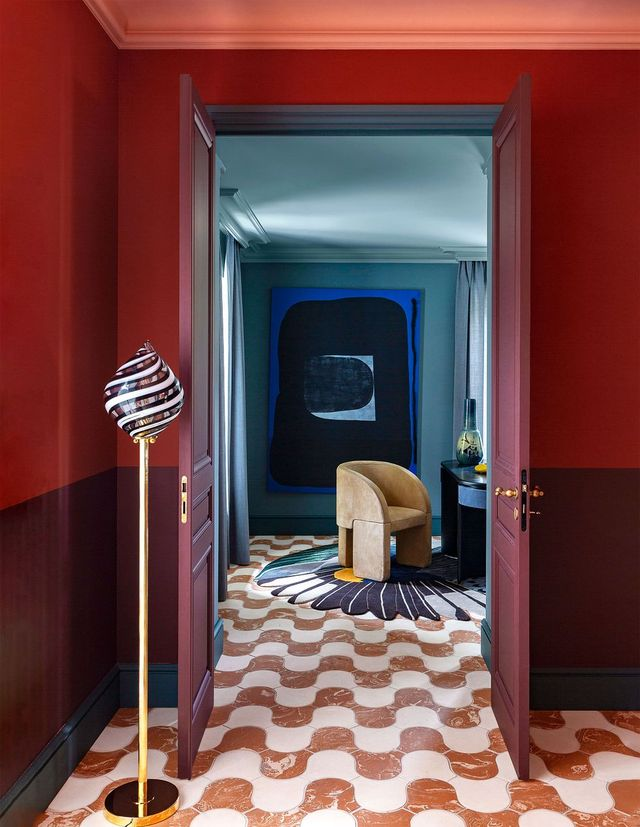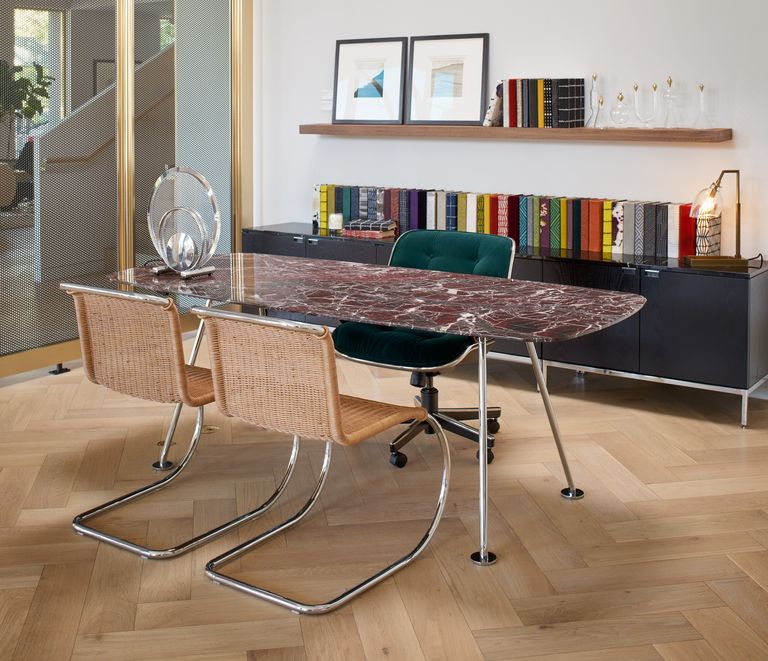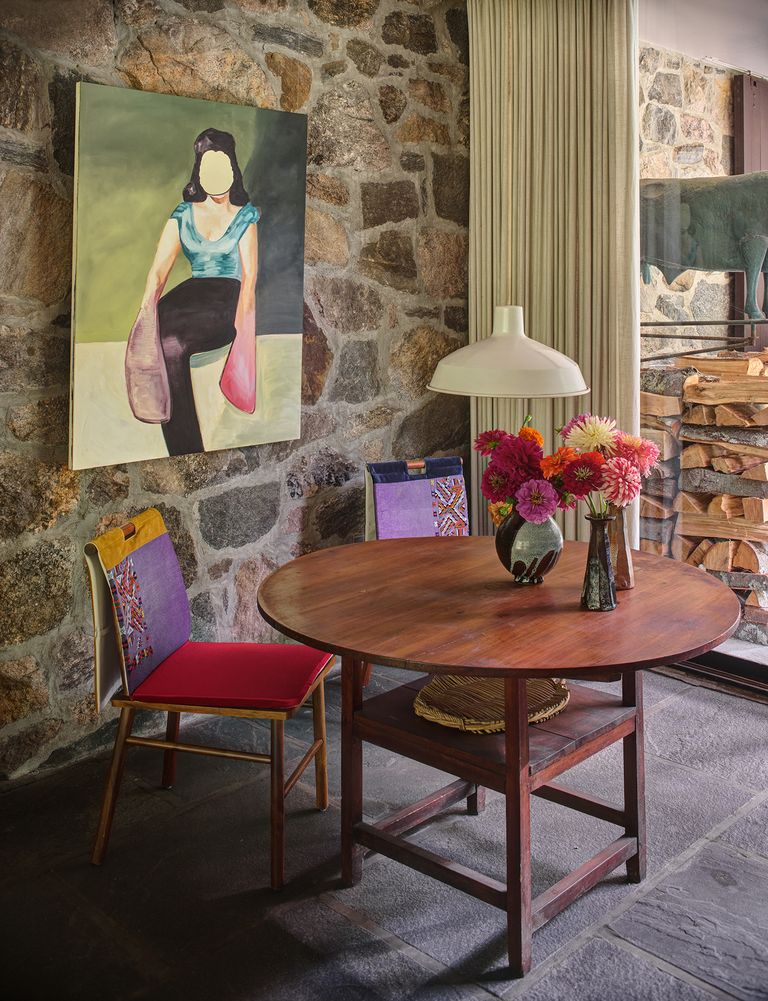THESE INTERIOR DESIGN TRENDS WILL DEFINE OUR HOMES IN 2022
2022.03.21
Nearly two years of intermittent lockdowns have turned us all into homebodies. But as we tentatively emerge from our cocoons, we might wonder what the future has in store for design. The disruption of our routines due to the pandemic has fundamentally transformed how we work and live at home, and the design trends and innovations of the year ahead will all reflect these shifts—perhaps permanently. The home may be more of a refuge than ever, but the more time we’ve spent staring at the walls, the more many of us have become visually restless and eager to make changes to our interiors. Thanks to Zoom, we’ve invited countless colleagues, friends, and family for a virtual peek into our personal spaces, but many of us are only tentatively stepping back into real life entertaining. We know what “before” looked like at home—how about “after”? We tapped the experts to find out.
COLORS ARE ABOUT TO GET PUNCHIER

Wondering what colors might calm us, inspire us, or make us feel rooted in our homes? Expert Joa Studholme, international color curator at Farrow & Ball, says that the challenges of the past two years have ushered in “a seismic shift in the way we’re using colors in the home,” noting that neutrals seem to be giving way to bold, distinctive hues that imbue our interior spaces with a certain strength of character.
But don’t expect interiors to go neon just yet: “The colors we use will be strong but modest, which suits both the way we feel now and the simpler lives we’re leading after a year of turmoil,” Studholme predicts. She says colors that evoke folk art and crafts—jewel tones like Farrow & Ball’s Breakfast Room Green, Stone Blue, and Incarnadine—are lending interiors a kind of rootedness in what she terms the “modest character” and virtues of the simple life. “Function goes hand in hand with ornament,” she explains, “And of course, we are still particularly attracted to colors that reflect the natural world and make us feel safe. We will continue to see the use of green in connecting the exterior with the interior.”
On that score, Studholme’s prediction is in line with that of most of the major paint brands, whose picks for the 2022 color of the year resemble the verdant interior of a lush greenhouse. Benjamin Moore’s October Mist is a soft pistachio, Sherwin Williams’s Evergreen Fog is a subdued gray-green, Glidden’s Guacamole is a modern take on the early ’70s classic hue, and Behr’s Breezeway is a light, delicate celadon.
“SOFT CONTRACT” FURNITURE AND ZOOM ROOMS ARE IN...
For 1stDibs contemporary design specialist Jude Hughes, the distinction between professional and domestic spaces—once sacrosanct—is now blurred. These changes in how we used our personal spheres are, in his words, “challenging traditional ideas of ownership and private space.”
“[T]here is an increased interest in nomadic and flexible-use objects,” Hughes explains of these adaptable, multifunctional furnishings. “Many furniture designs have become more ‘soft contract’ where active comfort forms are intended to meet the needs of this hybrid [live/work] environment.” In other words, the notion that rooms and furnishings have dedicated uses and finite configurations is a thing of the past; our homes are evolving into a movable feast.

From Los Angeles, Meaghan Roddy, the West Coast head of design at Phillips, reports that the interior designers she speaks to have more projects than they know what to do with and that, thanks to the pandemic, “there is more focus on ‘home,’ and not necessarily entertaining in the home but about really living and working in a home space and having the flexibility to do both comfortably.” Noting that auction results in 2020 and 2021 have been “extremely strong,” the sense is that clients used their at-home time to finish design projects they’d let linger. “Anecdotally, we did hear of a designer designing a ‘zoom room’ for a client, which honestly is genius,” she adds.
...BUT KEEPING UP APPEARANCES IS OUT
One group for whom transparency and flexibility are likely here to stay is families with multiple generations under one roof. Curators Michelle Millar Fisher and Amber Winick— whose groundbreaking project Designing Motherhood explores the material culture of pregnancy, birth, and beyond—both say they’ve observed a new kind of frankness when it comes to what appears on Zoom and how people juggle competing needs in their homes. “I think there’s going to be (literally) more transparency because the interior of our homes is now where we do many different things, including simultaneously living our lives, caring for people, and working, often on Zoom where other people can see our interiors,” Fisher says.
Winick, who has three young children and a busy work schedule, says that this phenomenon has brought kids and their stuff very much into the picture—another reason to employ nomadic furniture. “Personally I’m embracing it (what is the choice really?!) and so kids’ artwork is displayed on the walls as my Zoom backdrop. I’ve noticed a lot more in the way of modular furniture...enabling flexible spaces that can easily transform to fit differing needs throughout the day.”
CRAFT WILL BE KING

Another powerful impulse among designers and collectors alike is the desire to surround oneself with handcrafted, artisanal objects—both old and new. Abby Bangser, founder of the art and design fair Object + Thing, says that lately there’s “an interest in handmade and crafted objects, collected over time, so there’s more potential in a homeowner’s personality coming out through the objects they’re surrounding themselves with.” In a sense, it’s due to the uniqueness and personal touch of each thing: “Maybe that goes back to how conscious we are of our humanity right now [due to the pandemic]—these objects that we live with are made by real people,” Bangser says.
Sean Scherer, proprietor of the Kingston, New York, antiques gallery Kabinett and Kammer and author of the book Creating Authentic Interiors, says that objects that were once used quite humbly—and very much “below stairs” are as popular as ever. “Primitive utilitarian items like wood milking stools, carved dough bowls, and beautiful worn cutting boards are on trend,” Scherer says. “They transcend periods and styles perfectly at home in a traditional or modern interior.”
Rebecca Gardner, the founder and creative director of Houses and Parties, an event and interiors design practice in New York City and Savannah, Georgia, says that recently her clients are gravitating toward a rich, layered aesthetic. “The vintage on my website goes first,” she says, noting “an ongoing enthusiasm for texture, layers, and unabashed color.”
The crafted look is even showing up in the architectural details that make a home. Shannon Maldonado, the owner of Philadelphia design mecca Yowie, says that vividly hued ceramic objects and tiles won’t be fading from view anytime soon. “An emerging trend I’ve been seeing is tiles used as a wall trim or accent wall. It feels like the evolution of ceramic objects and the idea of adding handmade touches to your space. I especially love instances where I’ve seen it inset into doorways or as accent walls in bedrooms or living rooms instead of traditional wood millwork.”
RECYCLED MATERIALS WILL BE ALL THE RAGE

And green won’t just be for your walls next year: Designers are increasingly investing in and experimenting with sustainable materials to disrupt the direct-to-landfill model in any way they can.
Royce Epstein, art and design director at the Mohawk Group, the flooring company, calls it material mend. “It’s the practice of investigating and using new materials that can replace traditional plastics and other harmful materials in the design of products,” she says. “The best designer doing this today is Fernando Laposse. He is using indigenous corn from Mexico to make veneer and sisal as a byproduct of the tequila industry to make benches and other things.”
Jude Hughes, of 1stDibs, concurs: “Many studios are rethinking materials intended for temporary or industrial uses and reclaiming waste streams to produce surprisingly beautiful domestic objects,” he says, noting a strong interest in materials like cork, linen, and reclaimed plastics.
Shannon Maldonado, of Yowie, notes that high-density polyethylene (HPDE) and recycled plastic have caught her eye. “I’ve personally been inspired by the emergence of recycled plastics such as HPDE as a raw material for furniture and fixtures. Two recent projects that come to mind are the [fashion brand] Ganni stores, where it’s used as counters and storage units, and the Space Available x Peggy Gou ‘trash’ chair made from recycled plastic in Indonesia,” adding that she would be keen to use it herself in a future project.
THE RETURN OF WALL-TO-WALL CARPET (AND BASICALLY EVERYTHING ELSE 1970S)

Along with manufacturing processes that are gentle on people and the planet, furniture and surfaces are going soft. David Alhadeff, founder of the Future Perfect (who’s “obsessed” with 1970s design of late), says that certain elements of the glam decade are reemerging—particularly on the floor. “Wall-to-wall carpet was such a no-go for so long and now feels fresh again,” he observes. “At Casa Perfect, our terra-cotta wall-to-wall is lush and a hit with visitors. And sofas like our Marenco sofa, designed in 1970, are super popular again.”
On the walls, options inspired by Op Art abound: From Gucci’s new lifestyle line, G Hexagon wallpaper plays with geometry and scale in a color palette reminiscent of a vintage wrap dress, while Brutalist, an architectural fantasia from Ken Fulk’s new Cult of Beauty Collection, presents the facade of a severe modern building from the early 1960s shot through with cheery colors and a tangible sense of perspective.
Hughes sees this as a clear break with so-called rational design, where form has historically followed function: “Many designers instead have embraced surreal forms, in which the object always seems to be coming into being without ever solidifying. These practices embrace collage, animistic design, soft melting forms, and psychedelic color schemes.” Patricia Urquiola’s Dudet chair for Cassina—soft, solidly constructed, and evocative of languid ’70s glamour—can be upholstered in an array of earthy colors like teal, persimmon, and ochre. Hughes sums up this phenomenon as “legible comfort”—things that simply look soft and inviting, plump and rounded. And after such a challenging couple of years, what could be better?

















 Visitor Registration
Visitor Registration Booth Application
Booth Application